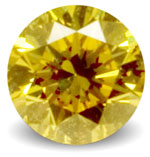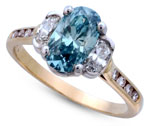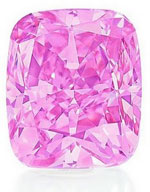Synthesized Diamonds—Scam update
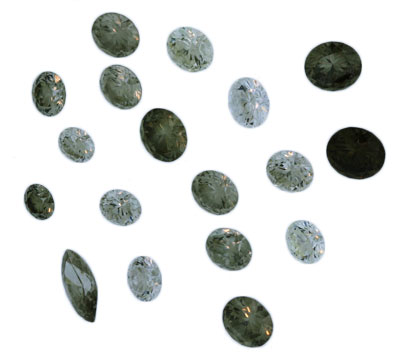 Advances in technology mean ever-more techniques for producing appealing diamonds at lower cost. Unfortunately, this also means increased opportunities for fraud.
Advances in technology mean ever-more techniques for producing appealing diamonds at lower cost. Unfortunately, this also means increased opportunities for fraud.
Earlier this summer a New York lab reported analyzing a batch of brown diamonds that were sold as natural, mined diamonds. It turned out that 75% of them were lab-made.
The buyer, an experienced gem dealer specializing in color-treated diamonds, had used a high-tech device to insure that the stones he bought were type IIa diamonds. These gems had all met that standard.
The fraud here is that the synthesized diamonds were mixed in with naturals, without disclosure. Lab-made diamonds sell for considerably less that mined stones, so the ease with which they were sold to an expert alarmed the industry.
The lab revealed that the synthesized diamonds were CVD-grown and HPHT-treated.
CVD, chemical vapor deposition, is a method used for some years to grow diamonds in the lab. But, as new versions of the process are developed, detecting the CVD diamonds is increasingly difficult.
HPHT, high pressure and high temperature, is a technique that’s been used both to create diamond and also to improve the color of natural mined diamonds, making them more appealing. In fact, the client in the above fraud bought what he took to be natural brown diamonds in order to color-enhance them. When he subjected them to HPHT, they did not respond as expected and this was a clue that they were not natural.
A surprising finding was that the synthetics in this batch reacted in different ways, suggesting that they did not come from the same lab. Instead, it appears there are a number of labs creating diamonds by different methods, and that several different rogue labs are willing to pass their gems into the market as natural.
There is no way to know how many lab-made gems are currently being sold by retailers as natural—and priced as natural.
Specialized equipment can sometimes help in detecting synthetic gems, but new proprietary processes mean that makers of such equipment are always playing catch-up. Most appraisers do not have access to the latest detection equipment.
REMINDERS & TIPS for Insurers
- Lab-grown diamonds are true diamonds, manufactured from the same material as natural diamonds dug from the earth. They have the same hardness and brilliance of the mined gems and all the same physical, chemical and optical properties.
Price
- Lab-made diamonds have a much lower valuation than mined diamonds.
Colored Diamonds
- In nature, intensely colored diamonds are VERY rare and are highly priced for that reason.
- Intensely colored gems can be made easily in the lab, and their prices should reflect this.
- In insuring colored diamond, or any diamond of high value, never assume the gem is natural (and therefore more valuable). Insist on an appraisal that states whether the stone is natural or synthetic.
- In replacing a diamond of high value, never assume that the stone is natural simply because the appraisal doesn’t mention synthetic. Use every means possible to determine whether it is natural or synthetic.
Disclosure
- The chain of disclosure for synthetic diamonds must be complete — laboratory, distributor, jewelry manufacturer, retailer, appraiser, buyer, and insurer. Note that the insurer suffers if there is a break anywhere in the chain.
- Since synthetic diamonds are difficult to detect, improperly trained retailers and appraisers may unwittingly pass on synthetic diamonds as naturals.
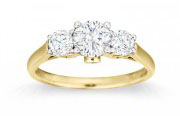 The insured may not have been told the gem is synthetic. Or, he may have been told verbally and may choose to withhold that information from the insurer.
The insured may not have been told the gem is synthetic. Or, he may have been told verbally and may choose to withhold that information from the insurer.- The appraisal should explicitly state whether the diamond is natural or synthetic.
- Chatham and Gemesis, two of the major makers of created diamonds, inscribe their names on the girdle of the stone, stating that the gem is lab-made. However, an inscription can be concealed when the stone is mounted in a setting, and laser inscriptions can be polished off.
- Disclosure information can be lost. Many jewelers have stories like the one of a customer who brought in inherited family jewelry, had the stones reset in an expensive setting, then had the jewelry appraised only to find out that the stones were synthetic. At the time of purchase, 60 or 80 years ago, it was understood to be inexpensive ornamental jewelry, but that knowledge slipped away.
- Disclosure information can get “lost.” A customer may buy jewelry with synthetic diamonds, not understanding the meaning of a term like cultured, for example, or not appreciating the extreme difference in value between natural and lab-made diamond. When he becomes aware that he made a bad purchase, he may sell it to the insurance company through a fraudulent claim.
FOR AGENTS & UNDERWRITERS
Jewelry, constituting about 10% of all inland marine business, was generally considered a profitable class of insurance. This has changed and could change more dramatically as more synthetic diamonds enter the market. If inexpensive lab-made stones start slipping in as naturals, the potential for overpayment on claims is enormous. We urge the industry to be proactive in dealing with these developments, before the losses take over and loss ratios plummet.
Now is the time to establish firm guidelines for insuring jewelry. It comes down to relying on people and documentation you can trust. We suggest the following:
- Certification by a Reliable Lab. Labs can afford the instruments needed to distinguish natural diamonds from their less valuable counterparts that are lab-grown. Not all labs are reliable. We recommend the following highly respected labs and suggest that you use these links to verify reports you receive.
GIA Report Check
AGS Report Verification
GCAL Certificate Search
GIA tests every diamond to determine if it is natural. If a diamond is found to be laboratory-grown, GIA issues a Synthetic Diamond Grading Report, which looks distinctly different from its standard grading report. As an added precaution, GIA also laser-inscribes the diamond's girdle with a report number and a statement that the diamond has been laboratory-grown.
- JISO Appraisal. For all quality jewelry, request a JISO 78/79 appraisal that gives a detailed description of the jewelry, both stones and setting, and gives a valuation. This appraisal is prepared by a trained gemologist (GG, FGA+, or equivalent), preferably one who has additional training in appraising for insurance. One course offering such training is the Certified Insurance Appraiser™ course.
FOR ADJUSTERS
With diamonds, the price difference between natural and synthetic is far greater than with most other stones. Mistaking a synthetic diamond for a natural could mean an overpayment of tens of thousands of dollars.
Read carefully all documents on file. Do not assume that a gem is natural unless this is specifically stated on the appraisal.
The word synthetic has unpleasant associations for some buyers who think it means fake (it doesn’t), so gem manufacturers may use other terms to describe their lab-made gems. Look over the appraisal and diamond report for such terms as created, grown, lab-made, man-made, lab-grown, and cultured diamond.
Often synthetic diamonds are identified by the manufacturer's name, such as Gemesis or Chatham, so carefully inspect the appraisal and sales documents for any brand names. Recognizing these names, or working with a jewelry expert who does, could save you thousands of dollars on a claim.
For jewelry with fancy colored diamonds, a price that's "too good to be true" is a major red flag. Do insurance to value (ITV) calculations to check for a large discrepancy between purchase price and replacement cost.
Be suspicious if a certificate/report from a lab includes a valuation. Reputable grading labs only report the qualities of the gem; they do not include valuation.
If a claim is made for damage, always have the damaged jewelry examined in a gem lab by a trained gemologist (GG, FGA+, or equivalent), preferably one who has additional training in appraising for insurance. One course offering such training is the Certified Insurance Appraiser™ course.
©2000-2025, JCRS Inland Marine Solutions, Inc. All Rights Reserved. www.jcrs.com
- The chain of disclosure for synthetic diamonds must be complete — laboratory, distributor, jewelry manufacturer, retailer, appraiser, buyer, and insurer. Note that the insurer suffers if there is a break anywhere in the chain.
- Since synthetic diamonds are difficult to detect, improperly trained retailers and appraisers may unwittingly pass on synthetic diamonds as naturals.
 The insured may not have been told the gem is synthetic. Or, he may have been told verbally and may choose to withhold that information from the insurer.
The insured may not have been told the gem is synthetic. Or, he may have been told verbally and may choose to withhold that information from the insurer.- The appraisal should explicitly state whether the diamond is natural or synthetic.
- Chatham and Gemesis, two of the major makers of created diamonds, inscribe their names on the girdle of the stone, stating that the gem is lab-made. However, an inscription can be concealed when the stone is mounted in a setting, and laser inscriptions can be polished off.
- Disclosure information can be lost. Many jewelers have stories like the one of a customer who brought in inherited family jewelry, had the stones reset in an expensive setting, then had the jewelry appraised only to find out that the stones were synthetic. At the time of purchase, 60 or 80 years ago, it was understood to be inexpensive ornamental jewelry, but that knowledge slipped away.
- Disclosure information can get “lost.” A customer may buy jewelry with synthetic diamonds, not understanding the meaning of a term like cultured, for example, or not appreciating the extreme difference in value between natural and lab-made diamond. When he becomes aware that he made a bad purchase, he may sell it to the insurance company through a fraudulent claim.
FOR AGENTS & UNDERWRITERS
AGS Report Verification
GCAL Certificate Search
For jewelry with fancy colored diamonds, a price that's "too good to be true" is a major red flag. Do insurance to value (ITV) calculations to check for a large discrepancy between purchase price and replacement cost.

